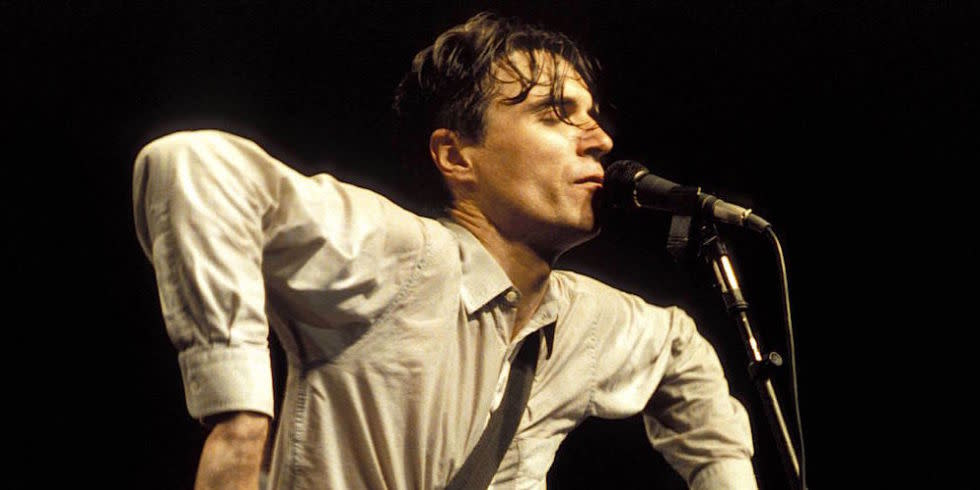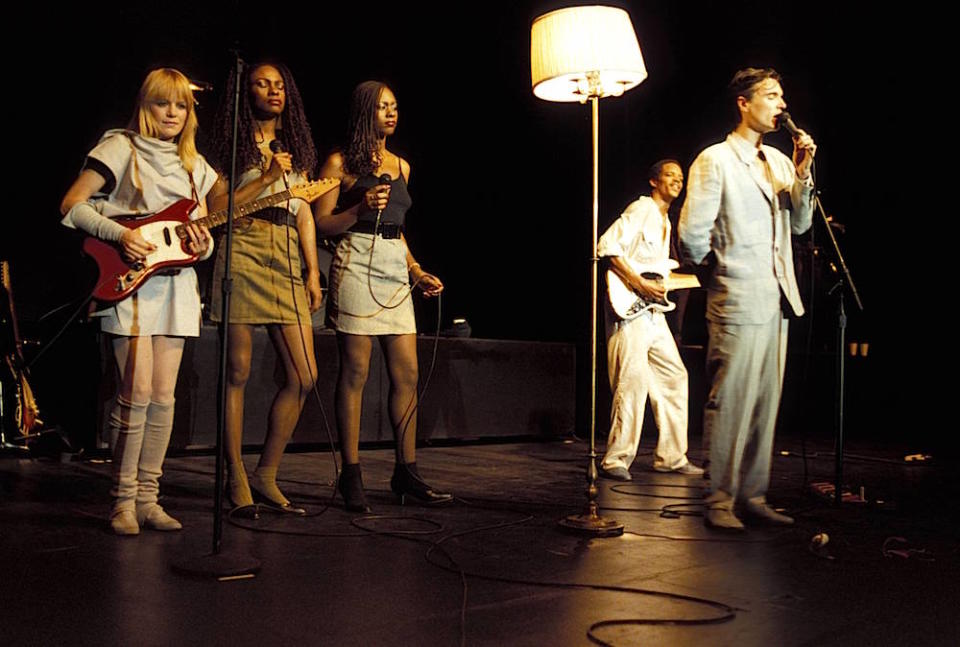Why 'Stop Making Sense' Remains the Greatest Concert Film

On Wednesday night, David Byrne shared a letter he wrote hours after learning about the death of iconic director Jonathan Demme. "One could sense his love of ordinary people," Byrne, the beloved frontman of Talking Heads, wrote of the filmmaker's ability to capture live music. "Jonathan's skill was to see the show almost as a theatrical ensemble piece, in which the characters and their quirks would be introduced to the audience, and you'd get to know the band as people, each with their distinct personalities. They became your friends, in a sense."
Though there's much to applaud Demme for, it's Stop Making Sense, the 1984 Talking Heads concert film, that remains one of his finest contributions to the craft. He was the champion of cinematic intimacy, and in the case of this film in particular, that authenticity is unparalleled. Stop Making Sense is a concert film about Talking Heads, yes, but it earns the title of the greatest concert film of all time by humanizing the artists through carefully constructed editing.
At the time, Talking Heads were already in the peak of their career and had a fan following to match it. "Psycho Killer," "Take Me to the River," and "Life During Wartime" charted on the Billboard Hot 100 over five years earlier. Their live shows were already the stuff of legend. In fact, the band raised the Stop Making Sense's budget of $1.2 million themselves, a sizable chunk of which came from the heavy rotation of "Burning Down the House" on MTV. Though their music was popular, the members were seen as art kid weirdos, bearers of new wave that seemed fun at a distance. That type of ubiquitous fame left Demme in a strange position: How do you portray a popular band in a way fans hadn't been seen before, especially to those who don't think of them as people?
How do you portray a popular band in a way fans hadn't been seen before, especially to those who don't think of them as people?
As a filmmaker, Demme gave Talking Heads a newfound, personalized intimacy. Individual narratives throughout the performance show each member coming into their own, a transformation viewers can relate to (at the very least because of surviving puberty). There's no script. There's no narration. There are no interview voiceovers. It's all done through visuals and music alone. Close-ups frame the characters-singer-guitarist David Byrne, bassist Tina Weymouth, drummer Chris Frantz, and keyboardist-guitarist Jerry Harrison-so they become their own blank slab of marble, allowing viewers to project themselves onto them.

Before we go any further, let's make one thing clear: All conceptual ideas came from David Byrne. Demme wasn't trying to create an idea of the band. In fact, he didn't give them any directions at all. "The only directions we got were from Gary Goetzman, who was technically the producer," Frantz said in an interview. "Gary said, 'Don't look at the camera and, for God's sake, don't pick your nose.'" It may seem lazy or unconventional, but backing away let the four relax on camera and be themselves. As any parent can attest, that's a critical part of letting a child develop. That natural flow of action allowed them to give an honest performance and, in tandem, demolish whatever barrier there could have been between musician and onlooker.
Stop Making Sense unfolds the way Talking Heads envisioned it, but Demme's directorial decisions change how look at it. This begins with Byrne standing on a bare stage, alone, singing an acoustic rendition of "Psycho Killer." He looks frail, tufts of hair curling on his forehead, and despite singing with his trademark gusto and circling around, he looks a bit overwhelmed. It's just him and the stage. Demme tracks much of the scene with a wide shot. He exaggerates Byrne's isolation and, by extension, outside pressure of his character.
As each member takes the stage, Demme quietly glues the spotlight to them. Weymouth appears with a nervous smile. Demme keeps her and Byrne in the frame, equally distanced, to compare their progression-Weymouth's feet stay tucked in; Byrne moves a little more freely, already comfortable with the stage. Then Frantz climbs his drum riser and salutes the crowd. Demme circles the drumset to frame Frantz's point of view as Weymouth can be seen swinging her hips, relaxed. The same thing happens when Jerry Harrison joins: a tightened spotlight shot, a group frame, and then a bit of relaxation. In his letter, Byrne admits he was too focused on the music, staging, and lighting to notice this attention to intimacy in real time. When watching the finished product, it became clear just how determined Demme was to hinge the documentary on their personalities, not just the music, which is ultimately what gives Stop Making Sense its timeless charm.
Less than 20 minutes in, we see everyone embrace their personalities with newfound gaiety during "Burning Down the House." From then on, the iconic moments come in waves. The scrawny Byrne we saw at the beginning is now twirling a lamp with the wide-eyed amazement of a child and dancing in an enormous suit. The polite Frantz from earlier snarls demonically during Tom Tom Club's "Genius of Love." Weymouth finally moves her feet, now kicking them at full speed while laughing joyously. Even Harrison, who kept a stiff upper lip at the start, playfully dances with backing singers Lynn Mabry and Ednah Holt, all three pointing at one another and synchronizing their dance moves. By filming over the course of four nights at the Pantages Theater in Los Angeles, Demme had enough footage to cherry-pick the best moments, all the way down to seemingly nondescript eyebrow raises and drum fills. He isn't trying to make them look cool. That's not important. He's trying to reveal their idiosyncrasies, their mirth, their personalities as both musicians and friends. It's not the scenes that stick with you long after Stop Making Sense ends, but Talking Heads' endearing personalities in these scenes.
Perhaps the most brilliant feat on Demme's end is positioning viewers as audience members. He barely shows the audience. He barely lets us hear them, too. You can hear their cheers, but they sound muted-which, as anyone can note while watching the film, couldn't be feasible given the contagious energy of the set. Yet when Demme does catch the audience in the background or flashes a close-up of the front row, everyone's beaming. Over the course of the film, the audience slowly stands, they dance in place, and, come the end, they take over the aisles to bust a move. It's the joy of letting loose. It's the joy of being weird. It's the joy of letting music direct you whatever way makes sense, and Demme's portrayal of the audience mirrors that.
Think of Demme's point of view. During the opening, we see Byrne's feet slowly walk to the edge of the stage, he places the jukebox down, and the one-take shot pans up-not to sexualize him, but to reveal him. It's the thrill of seeing a musician take the stage. For those actually in the room, however, the show begins with a camera operator blocking Byrne while they move backwards to track his movement. Demme blurs the hard truth of documentary by lacing pre-recorded audience cheers over the scene. It's the magic of cinema. We're given the chance to relate to Byrne as if we're the audience members, even though obscurification halted the real audience members' opportunity for that.
Stop Making Sense is an unexpectedly intimate look at outsider musicians as people thanks to Demme's directorial work. He was a champion at delivering the details of a person's charisma: the flash of a side smirk, the invisible connection between band members, the burst of enthusiasm to be alive. In Stop Making Sense, he immortalized Talking Heads as the epitome of energetic, joyful absurdity and, without ever forcing it upon them, made viewers take pride in what makes them weird themselves. Over 30 years since its release, Stop Making Sense has yet to be out-done. Now when people feel the music pump through their veins with a sense of revitalized identity, they know to turn to the theater aisles or their living room, start dancing, and stop making sense. Talking Heads showed the floor was for letting loose, and Jonathan Demme made us realize we can do so, too.
You Might Also Like

